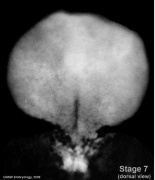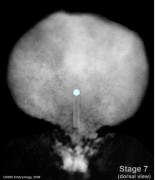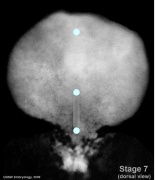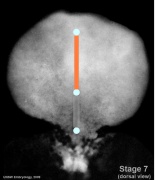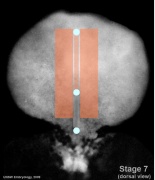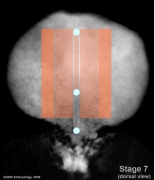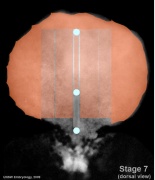File:Stage7 intermediate-mesoderm.jpg
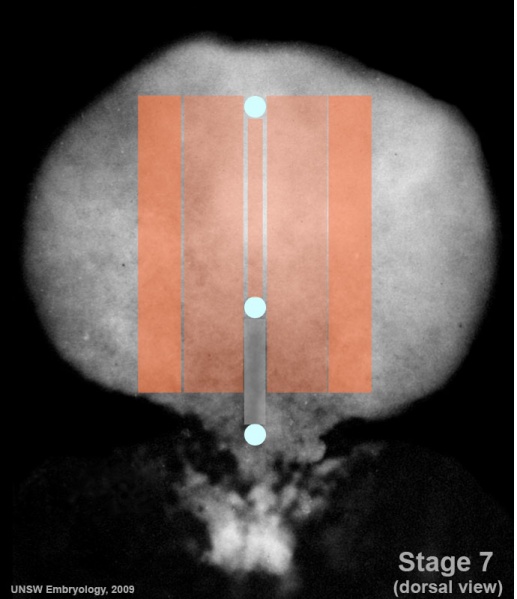
Original file (690 × 800 pixels, file size: 67 KB, MIME type: image/jpeg)
Carnegie Stage 7 showing the intermediate mesoderm region of the embryonic disc
Week 3, Carnegie stage 7 15 - 17 days, 0.4 mm, embryonic disc, showing the epiblast viewed from the amniotic (dorsal) side.
Developing in sequence 3 pairs of renal systems:
Carnegie Stage 7Facts: Week 3, 15 - 17 days, 0.4 mm Features: embryonic disc, primitive node, primative streak, primative groove, yolk sac View 1: embryonic disc, showing the epiblast viewed from the amniotic (dorsal) side. Events: Gastrulation is continuing as cells migrate from the epiblast, continuing to form mesoderm. Mesoderm lies between the ectoderm and endoderm as a continuous sheet except at the buccopharyngeal and cloacal membranes. These membranes have ectoderm and endoderm only and will lie at the rostral (head) and caudal (tail) of the gastrointestinal tract. From the primitive node a tube extends under the ectoderm in the opposite direction to the primitive streak. This tube forms first the axial process then notochordal process, then finally the notochord. The notochord is a key to embryonic folding and regulation of ectoderm and mesoderm differentiation. It lies in the rostrocordal axis and the embryonic disc will fold either side ventrally, pinching off a portion of the yolk sac to form the lining of the gastrointestinal tract.
|
|
- Embryo Stage 7 (dorsal)
Reference
Image Source: UNSW Embryology
No image reuse without permission.
Cite this page: Hill, M.A. (2024, April 16) Embryology Stage7 intermediate-mesoderm.jpg. Retrieved from https://embryology.med.unsw.edu.au/embryology/index.php/File:Stage7_intermediate-mesoderm.jpg
- © Dr Mark Hill 2024, UNSW Embryology ISBN: 978 0 7334 2609 4 - UNSW CRICOS Provider Code No. 00098G
File history
Click on a date/time to view the file as it appeared at that time.
| Date/Time | Thumbnail | Dimensions | User | Comment | |
|---|---|---|---|---|---|
| current | 11:29, 10 August 2009 | 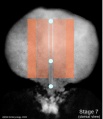 | 690 × 800 (67 KB) | MarkHill (talk | contribs) | Carnegie Stages 7 showing the intermediate mesoderm region of the embryonic disc. Features: embryonic disc, primitive node, primative streak, primative groove, yolk sac Facts: Week 3, 15 - 17 days, 0.4 mm View 1: embryonic disc, showing the epiblast vi |
You cannot overwrite this file.
File usage
The following 27 pages use this file:
- 2009 Lecture 5
- 2010 BGD Lecture - Development of the Embryo/Fetus 2
- 2010 BGD Practical 6 - Week 3
- 2010 Lab 3
- 2010 Lecture 5
- 2011 Lab 3 - Week 3
- ANAT2341 Lab 3 - Week 3
- BGDA Lecture - Development of the Embryo/Fetus 2
- BGDA Practical 7 - Week 3
- Lecture - Mesoderm Development
- Lecture - Renal Development
- Lecture - Week 3 Development
- Maternal-Fetal Medicine Trainees - Renal
- Mesoderm
- Renal System Development
- Talk:2010 BGD Practical 6 - Week 3
- Talk:2011 Lab 3
- File:Stage7-sem2.jpg
- File:Stage7 800x700px.jpg
- File:Stage7 cloacal-oral-membranes.jpg
- File:Stage7 intermediate-mesoderm.jpg
- File:Stage7 lateral-plate.jpg
- File:Stage7 mesoderm.jpg
- File:Stage7 notochord.jpg
- File:Stage7 paraxial-mesoderm.jpg
- File:Stage7 primitive-streak-node.jpg
- Template:Stage 7 mesoderm images
